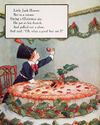
WITH its pristine white petals grouped around a yolky heart, chamomile adds cheer to our verges, cliffs and meadows in summer and releases a fruity fragrance when trodden underfoot. It's this sweet scent that explains its name, taken from the Greek word chamaimēlon, meaning earth apple.
Beneath the dainty bonnet is a rather unkempt plant: a scrawny member of the daisy family with ragged leaves that goes from tiny tot to teenager in the blink of an eye, blossoming after only 10 weeks. Yet, with blooms that last all summer, chamomile (Chamaemelum nobile) brings a little sunshine to terrace containers or formal borders and also mixes in well with wildflowers in uncultivated areas of the garden. The German variety is taller and more aromatic than the English (often called Roman) type, but both are said to be a boon to gardeners, not least because pests are indifferent to them. The longstanding belief that planting chamomile beside ailing crops helps to revive them has earned it the epithet 'the plant's physician'.
This modest little flower can cure humans, too, and boasts a rich medicinal history. It's thought that, as early as 1500BC, the Egyptians were making a balm from its petals to treat dry skin. The Greeks, for their part, found it a helpful diuretic and digestive aid. The flowers and the roots were made into a tonic to combat fever, inflammation and ulcers and a chamomile salve was applied to soothe burns and cuts.
Esta historia es de la edición May 15, 2024 de Country Life UK.
Comience su prueba gratuita de Magzter GOLD de 7 días para acceder a miles de historias premium seleccionadas y a más de 9,000 revistas y periódicos.
Ya eres suscriptor ? Conectar
Esta historia es de la edición May 15, 2024 de Country Life UK.
Comience su prueba gratuita de Magzter GOLD de 7 días para acceder a miles de historias premium seleccionadas y a más de 9,000 revistas y periódicos.
Ya eres suscriptor? Conectar

Save our family farms
IT Tremains to be seen whether the Government will listen to the more than 20,000 farming people who thronged Whitehall in central London on November 19 to protest against changes to inheritance tax that could destroy countless family farms, but the impact of the good-hearted, sombre crowds was immediate and positive.

A very good dog
THE Spanish Pointer (1766–68) by Stubbs, a landmark painting in that it is the artist’s first depiction of a dog, has only been exhibited once in the 250 years since it was painted.

The great astral sneeze
Aurora Borealis, linked to celestial reindeer, firefoxes and assassinations, is one of Nature's most mesmerising, if fickle displays and has made headlines this year. Harry Pearson finds out why

'What a good boy am I'
We think of them as the stuff of childhood, but nursery rhymes such as Little Jack Horner tell tales of decidedly adult carryings-on, discovers Ian Morton

Forever a chorister
The music-and way of living-of the cabaret performer Kit Hesketh-Harvey was rooted in his upbringing as a cathedral chorister, as his sister, Sarah Sands, discovered after his death

Best of British
In this collection of short (5,000-6,000-word) pen portraits, writes the author, 'I wanted to present a number of \"Great British Commanders\" as individuals; not because I am a devotee of the \"great man, or woman, school of history\", but simply because the task is interesting.' It is, and so are Michael Clarke's choices.

Old habits die hard
Once an antique dealer, always an antique dealer, even well into retirement age, as a crop of interesting sales past and future proves

It takes the biscuit
Biscuit tins, with their whimsical shapes and delightful motifs, spark nostalgic memories of grandmother's sweet tea, but they are a remarkably recent invention. Matthew Dennison pays tribute to the ingenious Victorians who devised them

It's always darkest before the dawn
After witnessing a particularly lacklustre and insipid dawn on a leaden November day, John Lewis-Stempel takes solace in the fleeting appearance of a rare black fox and a kestrel in hot pursuit of a pipistrelle bat

Tarrying in the mulberry shade
On a visit to the Gainsborough Museum in Sudbury, Suffolk, in August, I lost my husband for half an hour and began to get nervous. Fortunately, an attendant had spotted him vanishing under the cloak of the old mulberry tree in the garden.